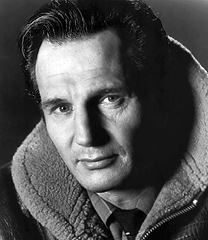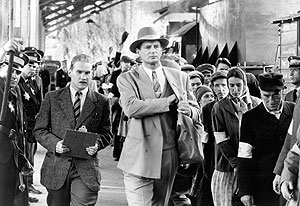For this week’s blog post, I will be discussing three different actors in the film Schindler’s List (1993).
Liam Neeson
(Video on Demand, 2006)
Liam Neeson in his role as Oskar Schindler, takes on the role of an impersonator. In the film, he takes the biography and story of Oskar Schindler and adds his own style to it to make it his own. As the the class text states, an impersonator copies “the manner, dialect, and behavior of a character, instead of creating the character” (Goodykoontz & Jacobs, 2014). However, while impersonating the real Oskar Schindler, Neeson puts his own spin on the character by adding his mannerisms and acting style to the role, which allows him to also fall under the interpreter category as well. Neeson’s acting style throughout this film is very realistic in that it doesn’t seem as though he is acting, but instead the actions that he is taking are his own. One of the most emotional scenes in the film is at the end of the film when Oskar Schindler has to flee the American army because he worked with the Nazi party. Even though he saved the lives of over a thousand Jews, at the time he was still considered part of the Nazi party.
Ralph Fiennes
(Pixgood, n.d.)
Ralph Fiennes plays one of the main characters in Schindler’s List (1993). In the film, he plays a sadistic Nazi officer who executes Jews and is very cruel. With the role of Amon Goeth, Fiennes takes on the role of impersonator with a twist of interpreter thrown into it. As with Liam Neeson’s character, Fiennes takes the role from biographies and stories of Amon Goeth. The acting style that Fiennes used in this film is very realistic, and can be seen in multiple scenes, but one scene in particular that stands out is when Schindler is talking to Goeth about power. Even though I have used this scene in last week’s post, I will be focusing on a different aspect of it. In this scene, Schindler talks to Goeth about true power being the ability to pardon another even when there is every justification to kill. In this scene, you can really see the emotions in Fiennes’ face and how he taking the talk to heart.
Ben Kingsley
(Cauthen, 2013)
Ben Kingsley played the role Itzhak Stern, Schindler’s jewish accountant, in the film. Kingsley’s role in the film can be seen the same as the other two actors. For this role, he is seen as a impersonator with a bit of interpretation as well. In this film, Kingsley’s acting is more realistic acting that it is stylized, as it is very difficult to tell if he is acting or if he is actually Itzhak Stern. Throughout the film, Kingsley constantly comes to Schindler’s aid in finding more Jews to bring out of the ghetto and camp and into freedom. One particular scene in which Kingsley plays his part very well is when he is creating a list of names to bring to the factory.
Focusing on Liam Neeson, his acting style as an actor in general, not necessarily in direct relation to this film is a wild card. According to the text, an actor who falls into the wild card category play such diverse roles that they are not able to fit into one specific category (Goodykoontz & Jacobs, 2014). For instance, in Schindler’s List (1993), Neeson plays the part of a non-violent compassionate character that saves lives. In another movie that Neeson is in, Taken (2008), he plays the role of ex-CIA agent who infiltrates a human trafficking ring and saves his daughter. In this movie he plays the hero, but he is also violent and it is a complete switch from his character in Schindler’s List.
References
Bayer, A. [ankit bayer]. (2011, June 3). Schindler’s List: what is power. [Video File]. Retrieved from https://www.youtube.com/watch?v=K5lQA3bipHc
Bayer, A. [ankit bayer]. (2011, June 3). Schindler’s List Ending Scene. [Video File]. Retrieved from https://www.youtube.com/watch?v=vOoWpTxKJGA
Cauthen, S. (2013, March 1). Celebrate the 20 Year Anniversary of SCHINDLER’S LIST with Movie and Behind-the-Scenes Stills. [Photo]. Retrieved from http://www.screenslam.com/schindlers-list-20-year-anniversary-pictures-steven-spielberg/
Goodykoontz, B., & Jacobs, C. (2014). Film: From Watching to Seeing. San Diego, CA: Bridgepoint Education, Inc.
GreatestMovieClips. (2012, June 18). Taken Phone Speech [HD]. [Video File]. Retrieved from https://www.youtube.com/watch?v=jZOywn1qArI
Movieclips. (2011, June 1). The List is Life – Schindler’s List (7/9) Movie CLIP (1993) HD. [Video File]. Retrieved from https://www.youtube.com/watch?v=CmyP-ljev68
Pixgood. (n.d.). Ralph Fiennes Liam Neeson Schindler’s List. [Photo]. Retrieved from http://pixgood.com/ralph-fiennes-liam-neeson-schindlers-list.html
Video on Demand. (2006). Liam Neeson. [Photo]. Retrieved from http://liam.neeson.szm.com/foto.html




